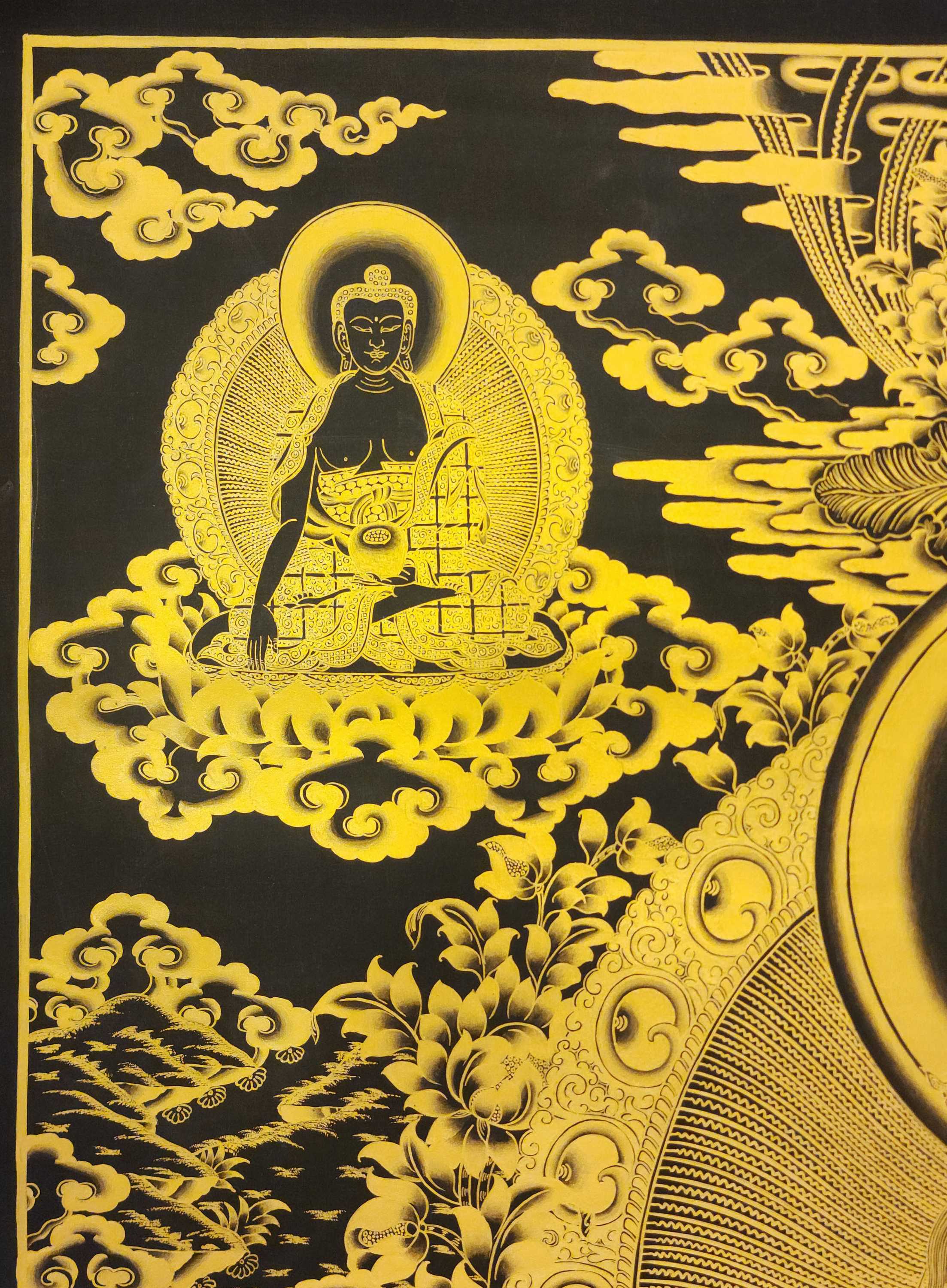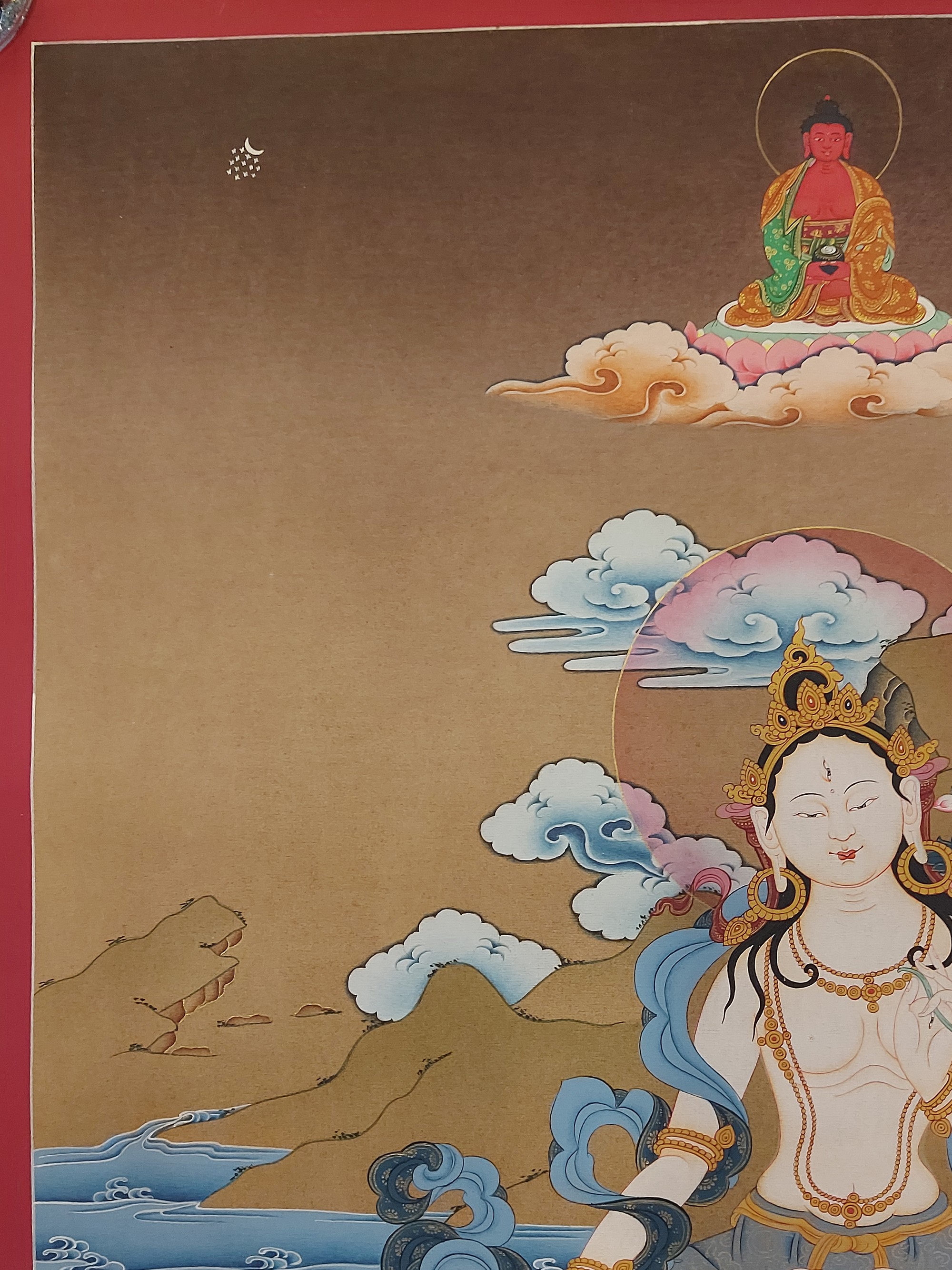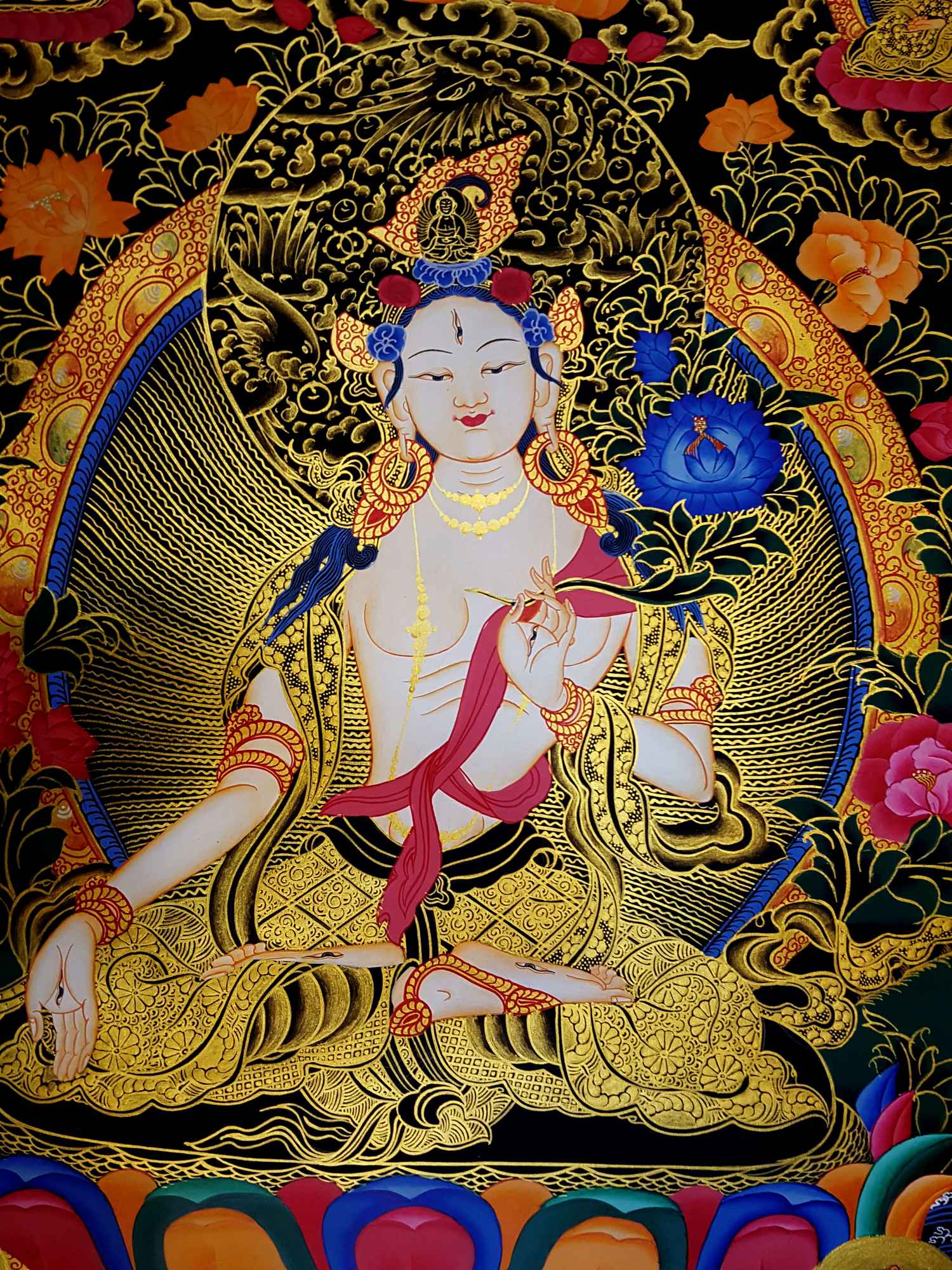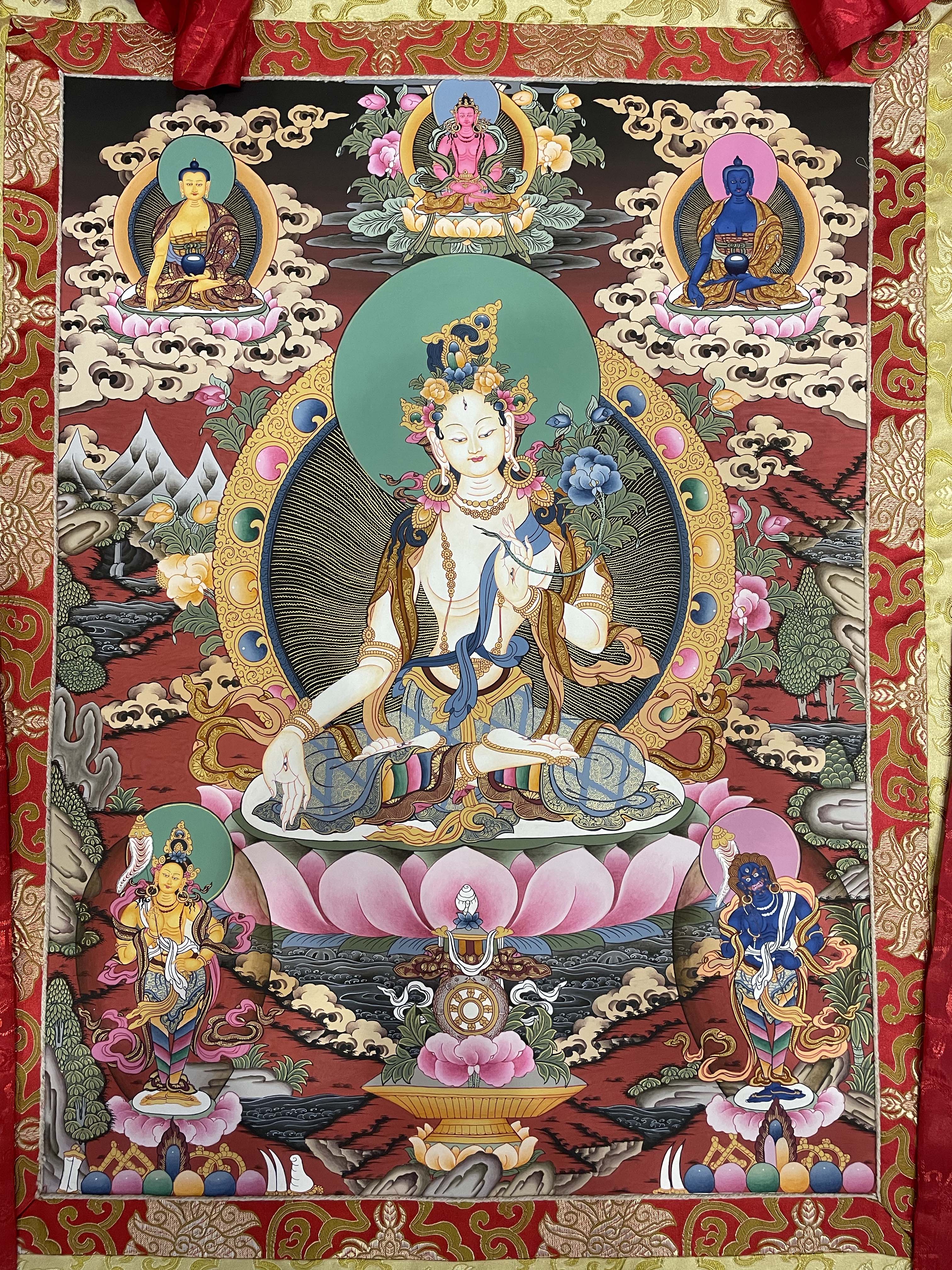Code
HCS29534
Weight
200 gm / 0.44 lbs
Size
Height
75cm (30") Width
50cm (20") Material
Cotton Canvas & Natural Color
Availability
Available

Safe Payment
We accept Paypal, Money Transfer, Bank Transfer
Confidence
Protection covers your purchase and personal data.
Worldwide Delivery
We ship Worldwide, except Russia.Shipping cost US$25.2 for upto 0.5 kgs

Hotline
Talk to help line for your question on 9841267335Three Long Life Deities : Brief Introduction
The set of Three Long-Life Deities consists of three healing and long-life deities: White Tara, Amitayus (Aparmita), and Ushnishavijaya (Namgyalma). The combined practice of these three deities offers a comprehensive approach to promoting longevity, well-being, and spiritual growth. By invoking their blessings collectively, practitioners aim to cultivate physical health, mental clarity, spiritual vitality, and the ability to navigate life's challenges. The prayers, mantras, and visualizations associated with these deities serve as powerful tools for developing inner qualities, purifying negativities, and fostering a positive and harmonious existence. Ultimately, the practice of the Three Long-Life Deities aims to support practitioners in leading long, healthy, and meaningful lives dedicated to the path of awakening. Read More . . .
The set of Three Long-Life Deities consists of three healing and long-life deities: White Tara, Amitayus (Aparmita), and Ushnishavijaya (Namgyalma). The combined practice of these three deities offers a comprehensive approach to promoting longevity, well-being, and spiritual growth. By invoking their blessings collectively, practitioners aim to cultivate physical health, mental clarity, spiritual vitality, and the ability to navigate life's challenges. The prayers, mantras, and visualizations associated with these deities serve as powerful tools for developing inner qualities, purifying negativities, and fostering a positive and harmonious existence. Ultimately, the practice of the Three Long-Life Deities aims to support practitioners in leading long, healthy, and meaningful lives dedicated to the path of awakening. Read More . . .
Karma Gadri Art : Karma Gadri Tradition: An introduction
Description inspired from Images of Englitment.
This Custom of Tibetan thangka painting started from the creative ordered trials of the eighth Karmapa, Mikyö Dorje (1507-1554). He was one of the most prestigious Karmapas, a great contemplation ace as well as a productive, and student. Energetic about human expression and an imaginative visionary. He generally urged his devotees to master painting and cheered for this action.
The name Karma Gadri (gar-bris) came from the Karmapa settlements
It was set up when Mikyo Dorje and his company needed to travel. He composed an incredible book on craftsmanship named "the Incomparable Sun Workmanship Manual". It was beneficial for future craftsmen.
This thangka painting custom was likewise kept up within a spot called Karshoma, in eastern Tibet. To this end, the custom is known as Karshöma.
Since the source is from the eighth Karmapa, it is an unadulterated Tibetan way of painting thangka.
Description inspired from Images of Englitment.
This Custom of Tibetan thangka painting started from the creative ordered trials of the eighth Karmapa, Mikyö Dorje (1507-1554). He was one of the most prestigious Karmapas, a great contemplation ace as well as a productive, and student. Energetic about human expression and an imaginative visionary. He generally urged his devotees to master painting and cheered for this action.
The name Karma Gadri (gar-bris) came from the Karmapa settlements
It was set up when Mikyo Dorje and his company needed to travel. He composed an incredible book on craftsmanship named "the Incomparable Sun Workmanship Manual". It was beneficial for future craftsmen.
This thangka painting custom was likewise kept up within a spot called Karshoma, in eastern Tibet. To this end, the custom is known as Karshöma.
Since the source is from the eighth Karmapa, it is an unadulterated Tibetan way of painting thangka.
Master Quality : What is master Quality?
The attribute of "master quality" distinguishes the White Tara Thangka, Buddhist Traditional Painting, Karma Gadri Art, [real Gold], With Three Long Life Deities as an embodiment of extraordinary craftsmanship and artistic excellence. This exceptional piece is directly handcrafted by an artist or craftsman of the highest categorization, reflecting their unparalleled skill and expertise. The uniqueness of White Tara Thangka, Buddhist Traditional Painting, Karma Gadri Art, [real Gold], With Three Long Life Deities lies in its exclusivity to the artist, making it a rare find with nearly impossible chances of finding an identical piece in the same category. While copies may exist, they can never truly replicate the essence of the original, as an artist or craftsman capable of creating such exceptional artistry would prefer to showcase their own creative vision rather than reproduce another's work. Read More . . .
The attribute of "master quality" distinguishes the White Tara Thangka, Buddhist Traditional Painting, Karma Gadri Art, [real Gold], With Three Long Life Deities as an embodiment of extraordinary craftsmanship and artistic excellence. This exceptional piece is directly handcrafted by an artist or craftsman of the highest categorization, reflecting their unparalleled skill and expertise. The uniqueness of White Tara Thangka, Buddhist Traditional Painting, Karma Gadri Art, [real Gold], With Three Long Life Deities lies in its exclusivity to the artist, making it a rare find with nearly impossible chances of finding an identical piece in the same category. While copies may exist, they can never truly replicate the essence of the original, as an artist or craftsman capable of creating such exceptional artistry would prefer to showcase their own creative vision rather than reproduce another's work. Read More . . .
Use of Real Gold
This thangka of White Tara Thangka, Buddhist Traditional Painting, Karma Gadri Art, [real Gold], With Three Long Life Deities has real gold painted on its surface along with other paints. This is an ancient process of decorating the thangka in Tibetan Buddhism, Here gold is ground into gold dust, which is then mixed with other undisclosed material to make it paintable on the canvas. this mixture is then mixed with transparent glue and painted on the thangka. Read More . . .
This thangka of White Tara Thangka, Buddhist Traditional Painting, Karma Gadri Art, [real Gold], With Three Long Life Deities has real gold painted on its surface along with other paints. This is an ancient process of decorating the thangka in Tibetan Buddhism, Here gold is ground into gold dust, which is then mixed with other undisclosed material to make it paintable on the canvas. this mixture is then mixed with transparent glue and painted on the thangka. Read More . . .
Introduction to Thangka
A thangka, also known as tangka, thanka, or tanka, is a vibrant and intricate Tibetan Buddhist painting that serves as a visual representation of spiritual teachings. Crafted with meticulous detail on cotton or silk appliqué, thangkas depict a wide range of subjects including Buddhist deities, sacred scenes, mandalas, and narrative stories. These sacred artworks are traditionally kept unframed and rolled up for storage, resembling ancient scrolls. To protect their delicate nature, thangkas are mounted on textile backings and often adorned with a silk cover on the front. Proper preservation in dry environments is crucial to maintain the integrity and longevity of the silk. Read More . . .
A thangka, also known as tangka, thanka, or tanka, is a vibrant and intricate Tibetan Buddhist painting that serves as a visual representation of spiritual teachings. Crafted with meticulous detail on cotton or silk appliqué, thangkas depict a wide range of subjects including Buddhist deities, sacred scenes, mandalas, and narrative stories. These sacred artworks are traditionally kept unframed and rolled up for storage, resembling ancient scrolls. To protect their delicate nature, thangkas are mounted on textile backings and often adorned with a silk cover on the front. Proper preservation in dry environments is crucial to maintain the integrity and longevity of the silk. Read More . . .
Brief Introduction :
White Tara is a revered figure in Buddhist mythology, often depicted as a compassionate and serene goddess. She embodies peace and emanates loving compassion, bringing grace and dignity to various situations. White Tara's presence encourages the emergence of goodness and positive outcomes in all circumstances. She upholds the Four Measureless States, which include Loving Kindness, Compassion, Sympathetic Joy, and Equanimity, encompassing past, present, and future circumstances. Additionally, White Tara is associated with the bestowing of longevity, symbolizing a long and healthy life. Her essence embodies the ideals of compassion and benevolence, making her a significant figure in Buddhist worship and spiritual practices.
Iconography :Sita Tara, popularly known as White Tara. She has emanated from Avalokiteshvara & in the Nepali Transcendent Buddha tradition is the consort of Vairochana, the central Transcendent Buddha. Her inner virtue of loving compassion is magnified by the simplicity of her presentation. White Tara is an important Vajrayana Buddhist figure since she embodies the principle of loving kindness, which is the central quality in the altruistic Bodhisattva presented through Mahayana Buddhism. Her main emblem is the Pink Lotus [Skt. Kamala] representing this main quality.
Her left hand is gracefully lowered in an empty open palm boon granting gesture [Skt. Varada Mudra]. White Tara has a blooming pink lotus & an unopened bud on either side of her body. The lotus in the painting is stylised as a peony & a chrysanthemum to provide artistic contrast with her lotus throne. The open blossom represents the present and the bud represents the future situations & Buddhas yet to be born. The future also refers to beneficial changes circumstances that she will help bring about. Her right hand wisdom hand is in the gesture of giving refuge [Skt. Sharanagamana]. The word refuge refers to the teaching of compassionate understanding which she imparts. The third finger touches the thumb to create a circle representing the union of wisdom and compassion, and the three extended fingers symbolise the Three Jewels of Buddhism A. The Buddha State B. The Body of teachings [Skt. Sangha] C. The Principles of the Universal form [Skt. Dharma]. The same hand holds the stem of a blue lotus [Skt. Utpala] representing change. The lower part of the stem below the bend represents the root of the lotus in the mud. The allegory of the Lotus refers to the something that grows from the obscurity of the mud & which eventually bursts open in the light. The lotus journey is one of inner awakening & enlightenment analogous to the human spirit. Buddhism shows us how to grow towards the light with profound teachings which help us to navigate away from burdens and sufferings which we may have by being materially minded, bitter & confused.
There is a lotus on her diadem bearing the Wish Granting Gem [Skt. Chintamani] surrounded by an aureole of fire symbolising auspicious blessings. The extra eye on her forehead, on the palms of her hands & soles of her feet represent her ability to see and understand the sufferings of all beings & her omniscient compassion toward the suffering. Avalokiteshvara [Tib. Chengresi] her progenitor also has a white body & extra eyes. The eyes denote psychic & supernatural power. The rainbow coloured leggings represent a mastery of Boddhi Nature [Skt. Siddhi] & a manifestation of the Sambhogakaya. The dark blue layer of clothing signifies Mantrayana practice. She is upon a white moon disk & has an orange sun aureole to representing her emanation their melting point [Skt. Nada]. There is a branch of an Ashoka Tree in the foreground. The word Ashoka means 'without sorrow' in other words she has no regrets about her behaviour. The tree linked to the Vedic God of love & sexual union Kamadeva which blossoms when a virtuous lady touches it. The triangular diamond rock formation in the foreground represents the Source of Reality [Skt. Dharmadaya] out of which deities arise & which is generated from emptiness by the seed syllable E. In the Indian language is a Triangular shaped letter D & so expressed in the triangular rock formations.
Commentary :Her left hand is gracefully lowered in an empty open palm boon granting gesture [Skt. Varada Mudra]. White Tara has a blooming pink lotus & an unopened bud on either side of her body. The lotus in the painting is stylised as a peony & a chrysanthemum to provide artistic contrast with her lotus throne. The open blossom represents the present and the bud represents the future situations & Buddhas yet to be born. The future also refers to beneficial changes circumstances that she will help bring about. Her right hand wisdom hand is in the gesture of giving refuge [Skt. Sharanagamana]. The word refuge refers to the teaching of compassionate understanding which she imparts. The third finger touches the thumb to create a circle representing the union of wisdom and compassion, and the three extended fingers symbolise the Three Jewels of Buddhism A. The Buddha State B. The Body of teachings [Skt. Sangha] C. The Principles of the Universal form [Skt. Dharma]. The same hand holds the stem of a blue lotus [Skt. Utpala] representing change. The lower part of the stem below the bend represents the root of the lotus in the mud. The allegory of the Lotus refers to the something that grows from the obscurity of the mud & which eventually bursts open in the light. The lotus journey is one of inner awakening & enlightenment analogous to the human spirit. Buddhism shows us how to grow towards the light with profound teachings which help us to navigate away from burdens and sufferings which we may have by being materially minded, bitter & confused.
There is a lotus on her diadem bearing the Wish Granting Gem [Skt. Chintamani] surrounded by an aureole of fire symbolising auspicious blessings. The extra eye on her forehead, on the palms of her hands & soles of her feet represent her ability to see and understand the sufferings of all beings & her omniscient compassion toward the suffering. Avalokiteshvara [Tib. Chengresi] her progenitor also has a white body & extra eyes. The eyes denote psychic & supernatural power. The rainbow coloured leggings represent a mastery of Boddhi Nature [Skt. Siddhi] & a manifestation of the Sambhogakaya. The dark blue layer of clothing signifies Mantrayana practice. She is upon a white moon disk & has an orange sun aureole to representing her emanation their melting point [Skt. Nada]. There is a branch of an Ashoka Tree in the foreground. The word Ashoka means 'without sorrow' in other words she has no regrets about her behaviour. The tree linked to the Vedic God of love & sexual union Kamadeva which blossoms when a virtuous lady touches it. The triangular diamond rock formation in the foreground represents the Source of Reality [Skt. Dharmadaya] out of which deities arise & which is generated from emptiness by the seed syllable E. In the Indian language is a Triangular shaped letter D & so expressed in the triangular rock formations.
Tara's are difficult to place being neither Deity nor Dakini. Tara's are commonly described as female emanations and aides of Buddhas. Deities tend to have consorts with whom they are having sexual intercourse. She has a special association with the Pink lotus which represents the arising of wisdom from the obscure depths of the mud and the flowering of the awoken wisdom. The mud symbolised the primeval state. As with the other emanations of Tara, she has come into being from the teardrop of Avalokateshwara the great Bodhisattva of compassion.
Mantra of White Tara
Om Tare Tuttare Ture Mama Ayuh Punya Jñana Pustim Kuru Svaha


![White Tara Thangka, Buddhist Traditional Painting, Karma Gadri Art, [real Gold], With Three Long Life Deities](https://handicraftseller.com/uploads/pics/product/thumb/2023/06/29534_1.jpg)
![White Tara Thangka, Buddhist Traditional Painting, Karma Gadri Art, [real Gold], With Three Long Life Deities](https://handicraftseller.com/uploads/pics/product/thumb/2023/06/29534_2.jpg)
![White Tara Thangka, Buddhist Traditional Painting, Karma Gadri Art, [real Gold], With Three Long Life Deities](https://handicraftseller.com/uploads/pics/product/thumb/2023/06/29534_3.jpg)
![White Tara Thangka, Buddhist Traditional Painting, Karma Gadri Art, [real Gold], With Three Long Life Deities](https://handicraftseller.com/uploads/pics/product/thumb/2023/06/29534_4.jpg)
![White Tara Thangka, Buddhist Traditional Painting, Karma Gadri Art, [real Gold], With Three Long Life Deities](https://handicraftseller.com/uploads/pics/product/thumb/2023/06/29534_5.jpg)
![White Tara Thangka, Buddhist Traditional Painting, Karma Gadri Art, [real Gold], With Three Long Life Deities](https://handicraftseller.com/uploads/pics/product/thumb/2023/06/29534.jpg)
![White Tara Thangka, Buddhist Traditional Painting, Karma Gadri Art, [real Gold], With Three Long Life Deities](https://handicraftseller.com/uploads/pics/product/thumb/2023/06/29534_0.jpg)










 Black
Black  Black
Black  of
of  of
of  Real Gold, Three Long Life Deities,
Real Gold, Three Long Life Deities,  Real Gold, Three Long Life Deities,
Real Gold, Three Long Life Deities,  Karma Gadri Art, Handmade Thangka
Karma Gadri Art, Handmade Thangka  Karma Gadri Art, Handmade Thangka
Karma Gadri Art, Handmade Thangka  of White Tara" title="Tibetan Thangka
of White Tara" title="Tibetan Thangka  of White Tara" title="Tibetan Thangka
of White Tara" title="Tibetan Thangka  of White Tara" title="Tibetan Thangka
of White Tara" title="Tibetan Thangka  of White Tara" title="Tibetan Thangka
of White Tara" title="Tibetan Thangka  of White Tara
of White Tara  of White Tara
of White Tara  of White Tara Thangka,
of White Tara Thangka,  of White Tara Thangka,
of White Tara Thangka,  with Amitabha Budhha Buddhist Handmade Thangka Painting, Karma Gadri Art,
with Amitabha Budhha Buddhist Handmade Thangka Painting, Karma Gadri Art,  with Amitabha Budhha Buddhist Handmade Thangka Painting, Karma Gadri Art,
with Amitabha Budhha Buddhist Handmade Thangka Painting, Karma Gadri Art,  of White Tara" title="Tibetan Thangka
of White Tara" title="Tibetan Thangka  of White Tara" title="Tibetan Thangka
of White Tara" title="Tibetan Thangka